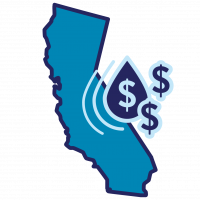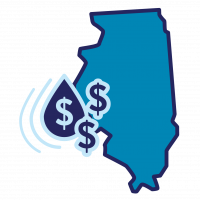State Action on Water Affordability
What’s the Issue?
The costs of drinking water and wastewater have more than doubled in the US since 2000. Multiple factors have led to higher water rates, including greater operational costs due to aging infrastructure and climate adaptation. To pay for these capital and operational costs of providing safe and clean water, water utility systems pass on their debt obligations and higher costs to consumers. Water affordability disproportionately affects low-income households and communities of color. The inability to pay for water bills can lead to additional charges, water shutoffs, foreclosure, and family separation. Water shutoffs led to compounded public health crises during the COVID-19 pandemic as running water is essential to preventing the spread of illness. The Pacific Institute defines water affordability such that the cost of essential water and sanitation should be inexpensive enough that cost does not prevent access, nor interfere with other essential expenditures (e.g., food, health care, housing, transportation education). Affordability (or lack thereof) can be thought as the level of burden a bill imposes on a customer as a percentage of income. Water equity and justice advocates center affordability as an environmental justice issue that affects the social, economic, and environmental well-being of communities. To learn more about the connection between water infrastructure and affordability, check out River Network’s Equitable Infrastructure Toolkit.
Affordability versus Assistance
While many water systems offer customer assistance programs (CAPs), alternative rate structures, or other payment relief programs, it is important to note the difference between affordability and assistance. Assistance programs can help address short-term inability to pay, but truly affordable water rates ensure residents are able to keep up with their water bills over the long-term. City- and state-level policies addressing affordability are creating innovative payment structures, funding mechanisms, and programs that promote transparency and accountability.
Examples of State Policy
- California: Assembly Bill 401 (2015) directed the State Water Board to develop a plan for a statewide Low-Income Water Rate Assistance (W-LIRA) Program by 2018. The state legislature passed Senate Bill 200 in 2019, establishing the Safe and Affordable Drinking Water (SADW) Fund. Starting in fiscal year 2020-2021, 5% of the annual proceeds of the Greenhouse Gas Reduction Fund (up to $130 million) will be deposited into the SADW Fund. Funds will support local assistance to “fund grants, loans, contracts, or services to help water systems provide safe and affordable drinking water.” The Safe and Affordable Funding for Equity and Resilience (SAFER) Program was developed from the fund.
- 2012
- 2015
- 2015
- 2018
- 2019
-
Senate Bill 88
State can force water system consolidation.
- Illinois: Two pieces of legislation created water affordability programs in 2021, including the Water and Sewer Financial Assistance Act (HB 0414), and the Lead Service Line Replacement and Notification Act (HB 3739). The Illinois Department of Commerce and Economic Opportunity will implement both programs. HB 0414 created a Water and Sewer Assistance Charge that water and sewer providers may choose to participate in, depositing the funds into the Water and Sewer Low-Income Assistance Fund. Funds will only be accessible to customers whose providers choose to participate. The amount of assistance will be determined by the greatest need for financial assistance in relation to household income. HB 3739 provided a high-level directive to establish a Low-income Water Assistance Policy and Program. Once established, the Department will disperse assistance such that the “highest amounts of assistance go to households with the greatest water costs in relation to household income. The Department may consider factors such as water costs, household size, household income, and region of the State when determining individual household benefits.”
Lessons from the Network
Additional Resources
- Navigating Legal Pathways to Rate-Funded Customer Assistance Programs. UNC Environmental Finance Center. (2017)
- “One Water for America Policy Framework” policy brief on redefining affordability for the 21st century. US Water Alliance. (2017)
- Measuring progress toward universal access to water and sanitation in California. Pacific Institute. (2018)
- Drinking Water Guide: A resource for advocates. River Network. (2019)
- Water/Color: A Study of Race and the Water Affordability Crisis in America’s Cities. Thurgood Marshall Institute at the NAACP Legal Defense and Educational Fund, Inc. (2019)
- The affordability of water and wastewater service in twelve U.S. cities: A social, business, and environmental concern. Robert Colton. (2020)
- The relationship between water shutoffs and COVID infections and deaths. Zhang, X. and Warner, M.E. (2021)
- Water Affordability Report. Environmental Policy Innovation Center. (2021)
- Water Service Affordability in Michigan: A Statewide Assessment. University of Michigan Water Center with MSU Extension Center and Safe Water Engineering. (2021)
- Water Affordability Advocacy Toolkit. NRDC and NCLC. (2022)
- 17 Percent of U.S. Households Face Growing Water Affordability Challenge, article on Duke University research. (2023)
- Full research article: Affordability of household water services across the United States, by LA Patterson, SA Bryson, & MW Doyle.
- Drinking Water Affordability in Kentucky. Appalachian Citizens’ Law Center. (2023)
- Podcast on New Jersey’s water affordability data transparency law, featuring Larry Levine from NRDC. WaterLoop. (2023)
- LIHWAP Implementation and Impact Report. Department of Health & Human Services. (2024)








